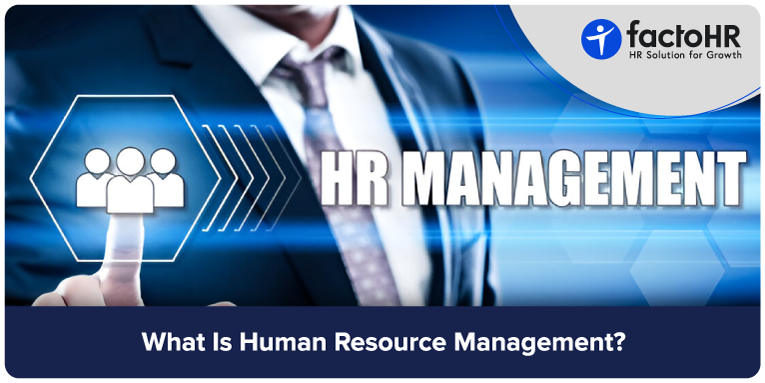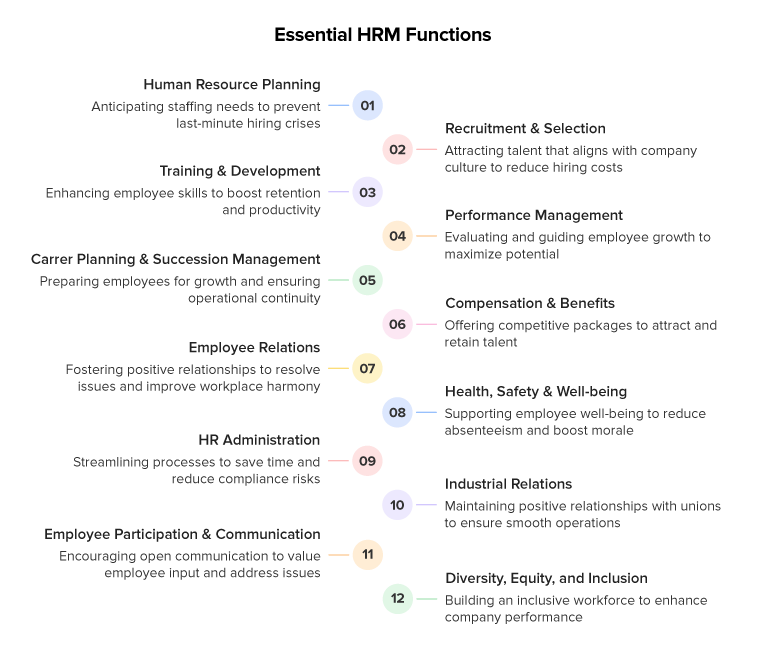HRM | What is Human Resource Management?

Table of Contents
Human resource management is crucial for any business in the current era. With increased demand for talent acquisition and the need for an efficient workforce, managing human capital becomes essential. HRM involves designing, developing, and implementing HR policies and practices for efficient employee management.
This is why understanding what human resource management is and its key objectives is essential. It will help define the practices to ensure streamlined HRM operations, policies, and workflows. This blog provides a comprehensive guide to human resource management, including its key functions, objectives, and emerging trends. So, let’s get started.

What is Human Resource Management?
Human resource management encompasses various practices related to staffing, hiring, organizing, and retaining qualified individuals who represent an organization. To effectively engage in HRM, it is essential to define the activities involved in the HRM process clearly. This includes crafting HR policies, understanding employees’ needs, expectations, and concerns, and regularly monitoring their performance to ensure ongoing support and effective management.
Why is Human Resource Management Important?
Some of the key reasons why business owners need to get their HRM planning right are,
- Talent acquisition and retention – To attract and retain top talent, having a robust Human Resource Management (HRM) system is essential. Your workforce, often called human capital, needs incentive programs, rewards, and recognition to stay engaged and committed to your company.
- Instrumental factors in HRM and staff education – A strong HRM system provides for never-ending knowledge exploration. Training, reskilling programs, and leadership development activities prepare employees for the future, helping reduce skill gaps. This is particularly important in fast-paced industries that face rapid changes.
- Workforce culture- Besides payroll and policy, HR has a significant role in forming and maintaining corporate culture. HRM can facilitate two-way communication, resolve conflicts promptly, and ensure an inclusive, supportive, and transparent work environment.
- Adjustment to changing workforce requirements – HR managers face new challenges, including remote onboarding, hybrid work policies, mental health initiatives, and DEI strategies. A practical HRM function can help the business maintain high standards and support employees during workplace transitions.
Objectives of Human Resource Management
Effective Human Resource Management is the backbone of successful small and mid-sized businesses. Its clear objectives drive organizational growth and employee satisfaction. Research indicates that companies with good HR practices tend to have 40% lower turnover rates and 12% higher profitability than those without structured HR management.
The four primary HRM objectives work together to create a thriving workplace environment.
- Societal objectives ensure that your business contributes positively to the community while maintaining legal compliance.
- Organizational objectives align your workforce with business goals, directly impacting your bottom line.
- Functional objectives aim to enhance HR processes by implementing efficient recruitment and training systems, thereby reducing hiring costs and expenses.
- Personal objectives focus on employee growth and satisfaction, which is crucial since employees leave their jobs due to poor management rather than compensation issues.

Key Functions of HRM
As a small or mid-sized business owner, you likely manage numerous responsibilities daily. By understanding the key functions of Human Resource Management, you can effectively expand your workforce and focus on the critical elements necessary for business growth.

1. Human Resource Planning (HRP)
Human resource planning helps you anticipate staffing needs before they become urgent, preventing costly last-minute hiring decisions that 68% of small businesses struggle with.
2. Recruitment & Selection
Recruiting talent becomes challenging when larger companies compete for the same candidates. Drawing in individuals who align with your company culture helps reduce expenses, as the typical hiring costs are steep for smaller businesses.
3. Training & Development
When your team receives structured training, employee retention and productivity increase, which is essential because everyone’s efforts directly affect your bottom line.
4. Performance Management
Regular performance reviews show you how to help every employee grow to their fullest potential. A well-structured performance management system identifies your top staff and helps prevent problems early, thereby avoiding losses your business might suffer from underperformance.
5. Career Planning & Succession Management
Growth planning also necessitates preparing your team for expansion. If succession planning is in place, the organization can continue to operate without its crucial employees.
6. Compensation & Benefits
Competing effectively isn’t limited to offering higher compensation. It’s also about building custom packages. Knowing what you spend on employee benefits makes it easier for you to compete and keep your spending under control.
7. Employee Relations
Strong employee relationships make it easier to resolve minor issues before they become significant problems. When employees have better team bonding, the workplace environment becomes more amicable and productivity improves for your organization.
8. Health, Safety & Well-Being
Employee well-being has a direct impact on productivity and reduces absenteeism costs. Review the steps you take to support employee well-being, as this can help them feel more motivated towards their work.
9. HR Administration
Streamlined HR processes save you time and reduce compliance risks. Efficient administration means fewer paperwork and more time focusing on growing your business.
10. Industrial Relations
Maintaining positive relationships with unions or employee groups (where applicable) ensures smooth operations and prevents costly disruptions that small businesses can’t afford.
11. Employee Participation & Communication
Open communication channels make employees feel valued and heard. Using feedback loops regularly helps you identify issues quickly and benefit from employee ideas for business growth.
12. Diversity, Equity, and Inclusion (DEI)
An inclusive workforce comprising diverse backgrounds can help a company outperform its rivals by up to 35%. Check your progress using DEI metrics to improve and develop your team.

How has Human Resource Management Changed and Evolved?
In the first half of the 1900s, human resources were primarily responsible for hiring and payroll, but they have become an essential aspect of the organization. With digital tools, smaller firms can now efficiently recruit and manage employee performance.
The post-pandemic era has seen a new evolution in HRM, characterized by the management of remote employees and a hybrid workforce. Today, you can achieve quicker developments and changes by using enterprise-grade HR resources and affordable strategies for small businesses, freeing you from corporate red tape.
Trends in HRM
Human Resources is undergoing a fundamental transformation. Organizations are recognizing the need for advanced HRM functionality and investing in emerging trends and innovative technologies.
Key trends shaping the HRM industry are:
AI-Driven Insights and Recruitment
Artificial intelligence is now an integral part of enterprise HR strategies. From predictive analytics that identify potential attrition risks to an AI-powered recruitment platform that enhances talent acquisition, data-driven approaches replace intuition and guesswork in critical decision-making.
Rising Employee Expectations
Today’s employees seek flexible work arrangements, comprehensive mental health support, and meaningful opportunities for career advancement. Meeting these expectations is vital for talent retention and engagement.
The Remote Work Paradigm Shift
Remote and hybrid work models have expanded the talent pool beyond geographic boundaries. Organizations can recruit top-tier professionals regardless of location, creating new efficiencies and opportunities, including re-evaluating real estate expenditures.
Diversity and Inclusion as Performance Drivers
Diversity and inclusion are no longer compliance checkboxes; they are strategic imperatives. Research consistently shows that diverse teams drive innovation and outperform homogeneous counterparts, making inclusive hiring and management practices essential.
Upskilling as a Strategic Necessity
In a rapidly evolving market, ongoing employee development is critical. Enterprises that invest in upskilling and reskilling initiatives are better positioned to retain top talent and reduce turnover, thereby ensuring long-term competitiveness and sustainability.

Conclusion
Human resource management encompasses not only managing employees but also planning and executing processes such as recruitment, performance evaluation, and employee well-being. All of these processes require a centralized approach that HRM software can provide. It can help determine policies, ensure implementation, and track adherence.
It can also help streamline key HRM functions and ensure organizational objectives are achieved. factoHR is a leading HRM software provider that offers scalable, cloud-based solutions for streamlined operations. To ensure HRM efficiency, schedule a demo now.
Grow your business with factoHR today
Focus on the significant decision-making tasks, transfer all your common repetitive HR tasks to factoHR and see the things falling into their place.

© 2025 Copyright factoHR


